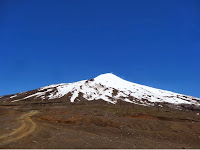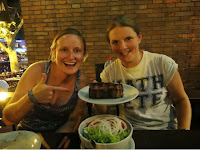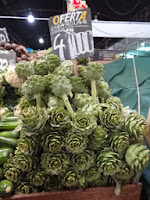 |
| Cactus Rose |
We booked a 4 day 'Salt Flats Tour' with
La Torre Tours. Afder doing substantial research on Trip Advisor and other travel sites and reading blogs we decided that the tours are much better from Tupiza than Uyuni. In Uyuni they have very inconsistent reviews, which is mainly down to the fact there are so many tour companies there and most of the drivers and cooks are 'freelance' so someone who is a questionable driver can work for several companies. In Tupiza there are only a handful of companies and La Torre Tours are the best from what we can tell.
 |
| Lots of Land Cruisers, and a Nissan |
Our tour started at 8am and we were shown to our
Land Cruiser and introduced to our driver, Mario, and our cook, Isabella. Both very lovely and cheery people. We handed our stuff to Mario who was standing on top of the truck loading our gear and provisions for the trip. We also met the other couple on our tour, Sue and Tom from Switzerland. It was just the 4 of us on the tour, there is a maximum of 5 people on a La Torre Tour (from Uyuni they pack 6 people + the driver and cook in the jeep!) and we took turns in sitting in the small child seats in the back of the Land Cruiser.
 |
| Very cold at the lagoon |
Day 1 is mostly driving to get us to the first nights' hotel, we start by passing the spectacular vertical red rock formations just outside Tupiza and then travel along winding dirt roads past some pretty amazing scenery(we will run out of superlatives in in this blog). We stopped for lunch at a small mining town where we had arrived on the day of the village school's 7th anniversary and they were having a presentation. It was quite sweet as the whole town (of less than a thousand) were out in the main square to celebrate the day. The food was great, Isabella had pre-made some chicken schnitzels and we had salad and potatoes to go with it.
We drove on through the Anawanapampa desert and Mario noticed one of the back tires had a small leak so we stopped on the road (dirt track) and he changed the tire (our second flat tire in 3 months, not bad considering all the miles we have covered!) we drove on and stopped in an abandoned town which the locals call a 'Ghost Town' it is where an army of Spanish lived after the invasion when they made the Inca's work the mines, at times not letting the Inca's out of the actual mine caves for months at a time, and they had to keep everything in there with them including the livestock! After a stop at our highest point of 4,855m we stayed overnight in San Antonio de Lipez at 4,200m in a hostel (no showers), all the acommodation on this tour is very basic and all 4 of us are in one room, with Isabella and Mario in another (even more basic than ours), there are toilets but as we said, no showers, not until the 3rd night when you can pay 10 Boliviano for a shower, well this is the desert and water is precious (and 10 Boliviano is less than a Pound!). Mario repaired the hole in the tire with the help of our torches - and removed the tire from the wheel by driving the jeep over the wheel and freeing the tube from inside, luckily Mario is a mechanic.
Day 2 began with an early start. Breakfast and we headed to the Lagoons, along the road we had to drive through several frozen streams which was quite amazing to see in the desert, it does get very cold in the desert at night. The first lagoon was our first glimpse of
Flamingos, they were just eating around the edges of the lagoon, some of it was still frozen and they were sliding along the surface. A little longer along the road we stopped at a lagoon we thought was covered in salt, this was in fact borax, which is used in the manufacture of ceramics.
 |
| Any guesses? |
About an hour later and we were at the gorgeous Laguna Verde (green lagoon). We stopped for photos before heading to the Aguas Termales just down the road, we all put our swimmers on and jumped in the springs, though very warm in the water outside it was blowing a gale and the wind was pushing the desert sand against us which meant we came out of the baths dirtier than when we went in, but as we keep saying 'it's an adventure!' After the springs we went to see the geisers, they were spewing hot gasses into the air - very cool to see. Next stop was at the red lagoon, this is where we saw hundreds of Flamingos. At our next hostel it was even more basic than the previous and colder too, so we used our rented sleeping bags which we really only needed because the beds looked like the sheets had not been changed, there were hairs and other bits in there. So we decided to sleep in the sleeping bags with the blankets over the top. We went outside before bed into the freezing night to see the stars, unfortunately the moon was very bright and this affected the ability to see all the stars, but being away from city lights and pollution it was still magnificent to see what we could.
 |
| Ah no, she's stuck |
The first stop on day 3 is at the rock tree, it is a rock which has the form of a tree sticking out of the desert, there are other rocks around and it is quite something to see. Tom climbed on top of a few of them, while we took photos of him and stayed relatively close to the ground.
We then headed off to the next lagoon where we saw a fox, it seemed quite used to people, tourists probably feed it. Here we saw many more
Flamingos, these were curiously more tame than the ones at the other lagoons. We were able to get within 2 meters of them and take some shots, it was extremely windy here and we had to really work hard to walk against the wind.
 |
| Viscacha |
We stopped for lunch near some rocks, where we saw
Viscachas (desert rabbit like animal) which were more than happy to see us as they eat all the crumbs left by the tours, probably not very good for them as you do not see carrots growing in the desert.
We stopped along the road to view the two volcanos
Licancabur and Zaparelli before stopping in a town for Mario to have a break after hours of driving in the desert, he told us that this section is very tiring for the drivers and they are not sure why this particular section is so bad.
That night we had nice hot showers at the hotel which was made of salt. The floor was rock salt (you have to wear shoes or it is very uncomfortable) and the walls are all salt, even the pillars for the beds are salt.
 |
| Cactus Island |
Up the next morning for the final day, we woke up 4.30 to see the sunset on the salt lake. It was magnificent and watching our shadows shorten as the sun rose was quite fun. We then drove to the
Isla Incahuasi, which is covered in Cactus plants, it is at the heart of the desert, quite amazing to see. Here we climbed the island (it is like a small mountain) and then had breakfast where Isabella had made us a cake!
 |
| one of the 'Crazy photos' |
It was then time for us to go to a section of the salt flats where we could take our crazy pictures. We spent 2 hours taking shots, some terrible, some quite good. Annoyingly our camera has some fluff and crap inside the lens so now all our shots have these spots. Will have to invest in photoshop when we get to Australia to clean our images. After our final lunch just on the shores of the flats, we arrived in
Uyuni and went to see the train graveyard - Uyuni used to be the centre of all trains in Bolivia but then a new government changed the hub to another city and the trains were just left to rust.
This is where we said goodbye to Mario, Isabella, Sue and Tom and we organised our 2 day transfer across the border to
San Pedro de Atacama while they all headed back to Tupiza.
It really was a brilliant trip, and having Sue and Tom with us was great - and not just because Sue can speak fluent Spanish and helped us out with the bits we could not understand.















































